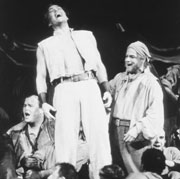BENJAMIN BRITTEN’S 1951 opera Billy Budd poses a formidable challenge to opera producers. Set on a British frigate during the Napoleonic Wars, its settings range from topmast to brig, challenging the ingenuity of designers while stage directors must find the drama in E.M. Forster’s libretto, adapted from Herman Melville’s beautiful but rather abstract novella of good and evil as yin and yang. And, of course, there’s not one woman to offer a touch of diva power.
Billy Budd
Opera House ends January 27
I acknowledge the challenges faced by the creators of the production currently on view at the Opera House. Presumably its peculiarities are intended to help put the piece across, not torpedo it. But nearly everything about this staging tends to diminish the work, both musically and dramatically.
Britten’s score is a marvel of colors; at one moment the huge orchestra conveys a battle at sea, whispered intimacies the next, suggesting now the airy spaces of the rigging, now the crowding darkness of the fo’c’sle. The predominant color of Alison Chitty’s setting and costumes is beige, relieved by dull black accents. For the variety of spaces specified by the libretto and the music we are provided a diamond-shaped beige platform, backed by beige gauze and what appears to be string. To one side is a stubby swept-wing mast (beige) from an art deco cruise ship. In the final scenes, a band of blue neon makes an appearance.
Britten went to a lot of trouble to differentiate his sailors by vocal type and range. Chitty erases the distinctions by putting pretty much everybody in tastefully distressed rags (beige). Her efforts are seconded by lighting designer Alan Burrett, who illuminates virtually every scene with bald white light from extreme angles, lending the performers a prison pallor and the spaces they inhabit the atmosphere of a subway platform between trains.
Christian R䴨 is credited as stage director here, but I am reliably informed that the Seattle production differs in no significant respect from Francesca Zambello’s original. And the show bears many family resemblances to earlier Zambello outings here: an inclination to direct against the musical flow, not with it; a tendency to draw attention from the character in dramatic focus by extraneous movement on the periphery of the action; in general, a fatal disinclination to leave well enough alone.
As a director Zambello makes me think of the mother of a reciting child, so determined that it make a good impression that she prompts hoarsely from the sidelines and rushes on stage from time to time to smooth away a cowlick. Only one scene is devoid of fidgety, distracting movement, and it is a scene in which the protagonist is alone and chained to the deck.
UNDER THE CIRCUMSTANCES it is hardly fair to criticize individual performances. Among those who manage to stand out against the general vagueness are the trio of junior officers of the good ship Indomitable, particularly Richard Stilwell, magnificently underparted (he himself used to sing Billy) in the role of Mr. Redburn. As “the Dansker,” the title character’s faithful friend, Gabor Andrasy demonstrates again an uncanny ability to ignore the fatuities occurring around him and turn in an affecting musico-dramatic performance. But the three performers upon whom any staging of the opera depends are variously hindered from making their maximum effect.
Suffering most is Jeffrey Wells. With his stature, poise, and inky bass, the role of evil John Claggart should be a piece of cake for him. But he has been encouraged, or allowed, to act the character’s evilness so broadly that the performance verges on that of Harvey Korman as the naughty psychiatrist in Mel Brooks’ High Anxiety, vampire teeth and all.
Opera houses have no trouble finding personable young Papagenos and Figaros; for some reason the title role of Billy Budd, which falls in the same vocal range, is considered dreadfully difficult to cast. Christopher Maltman has the voice and seems to have the raw material to be powerfully affecting in the part. His appearance has the kind of boyish candor required, and his rendition of the ballad Billy sings in chains was flawless. But, Angel of Goodness or not, Billy is still a character in a drama, and a pretty lurid one at that. The part requires lightning emotional adjustments to the wayward flow of events. Maltman’s rendition is still generic, an outline without texture or dimension.
The pivotal role of Captain Vere, fated to punish goodness for destroying evil, was in the hands of Peter Kazaras on opening night. Kazaras has done fine work for Seattle Opera, but as Vere he seems—forgive me—at sea. The crew of the Indomitable is ready to sail through hell for their captain; we need to understand why. Kazaras sings ably as ever, but his fretful, portly Napoleon look-alike could not inspire affection in a golden retriever.








